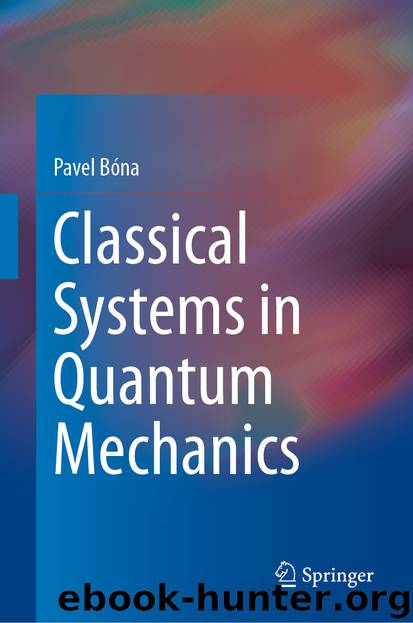Classical Systems in Quantum Mechanics by Pavel Bóna

Author:Pavel Bóna
Language: eng
Format: epub
ISBN: 9783030450700
Publisher: Springer International Publishing
(6.1.22)
We shall see in Sect. 6.3 that this intuitive construction leads to a rigorously defined group of -automorphisms of a -subalgebra of the -algebra containing the algebra as well as an algebra of classical observables in a natural manner. The algebra is then -invariant: contrary to the algebra (in a general case).
6.1.5
Remark. The general definition of mean-field time evolutions based on the formula (6.1.22) depends on a topology determined by the subset of states on (and their canonical normal extensions to ), so called ‘classical states’. The reason why we cannot use the set of all states () for the definition of can be seen from the thermodynamic limits of polynomial interactions described in Sect. 6.2: In the representations of containing the GNS-representations of states as their subrepresentations the thermodynamic limits of the local evolutions do not exist for a general Q. This fact can be seen from the definition of the projector in (5.1.120) as well as from considerations in Sect. 6.2. Although the resulting (algebraic) concept of can be used in certain cases to a definition of time evolution of all states on , such a definition scarcely can be considered as a physically correct consequence of the given interaction Q. This interaction does not lead to any reasonable (from the point of view of physics) time evolution of states of the infinite system, the central supports of which are orthogonal to i.e. Since the set is -invariant (as will be clear later), the time evolution of states , where I is the identity of , can be determined arbitrarily with a help of some group - Aut. The group has nothing to do, in a general case, with the evolution . For special choices of the function Q, however, the evolution can be defined on a larger subalgebra of than , hence also an evolution of a set of states larger than can be defined in a natural way, cf. also [40, Sect. II.C]. This can be seen on the following (seemingly trivial) example.
Download
This site does not store any files on its server. We only index and link to content provided by other sites. Please contact the content providers to delete copyright contents if any and email us, we'll remove relevant links or contents immediately.
Modelling of Convective Heat and Mass Transfer in Rotating Flows by Igor V. Shevchuk(6244)
Weapons of Math Destruction by Cathy O'Neil(5872)
Factfulness: Ten Reasons We're Wrong About the World – and Why Things Are Better Than You Think by Hans Rosling(4506)
Descartes' Error by Antonio Damasio(3170)
A Mind For Numbers: How to Excel at Math and Science (Even If You Flunked Algebra) by Barbara Oakley(3116)
Factfulness_Ten Reasons We're Wrong About the World_and Why Things Are Better Than You Think by Hans Rosling(3058)
TCP IP by Todd Lammle(3024)
Applied Predictive Modeling by Max Kuhn & Kjell Johnson(2919)
Fooled by Randomness: The Hidden Role of Chance in Life and in the Markets by Nassim Nicholas Taleb(2877)
The Tyranny of Metrics by Jerry Z. Muller(2865)
The Book of Numbers by Peter Bentley(2796)
The Great Unknown by Marcus du Sautoy(2549)
Once Upon an Algorithm by Martin Erwig(2484)
Easy Algebra Step-by-Step by Sandra Luna McCune(2480)
Lady Luck by Kristen Ashley(2427)
Practical Guide To Principal Component Methods in R (Multivariate Analysis Book 2) by Alboukadel Kassambara(2394)
Police Exams Prep 2018-2019 by Kaplan Test Prep(2369)
All Things Reconsidered by Bill Thompson III(2272)
Linear Time-Invariant Systems, Behaviors and Modules by Ulrich Oberst & Martin Scheicher & Ingrid Scheicher(2245)
